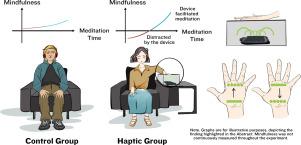正念触摸:半空触觉有助于新手在音频引导下的正念冥想的主观体验
IF 5.1
2区 计算机科学
Q1 COMPUTER SCIENCE, CYBERNETICS
International Journal of Human-Computer Studies
Pub Date : 2025-05-06
DOI:10.1016/j.ijhcs.2025.103528
引用次数: 0
摘要
面对永远充满压力的生活,人们会考虑通过正念冥想来放慢节奏。我们将HCI的研究扩展到先前对互动密集冥想技术的关注之外,仅仅关注一个人的触觉是否能促进冥想。我们利用空中触觉的无触感特性,在冥想时在手掌上呈现微妙的感觉,使用一种源自飞行员测试的设计。在一项新颖的探索性研究中,我们通过结合标准化问卷和微观现象学访谈的混合方法(每组n=10),比较了音频和听觉触觉指导对成年新手正念冥想的影响。有趣的是,半空触觉在数量上增加了障碍和放松,这似乎是相互矛盾的,但当与定性分析一起考虑时,实际上是互补的。具体来说,空中触觉最初分散了参与者的注意力,但最终通过三个过程(具体化隐喻、呼吸校准和冥想基础)促进了正念,尽管这需要进一步验证。我们认为未来需要探索一种综合的、多模式的冥想体验。本文章由计算机程序翻译,如有差异,请以英文原文为准。

Mindful touch: Mid-air haptics facilitates novices’ subjective experiences of audio-guided mindfulness meditation
With perpetually stressful lives, people are prompted to consider slowing down through mindfulness meditation. We extend HCI research beyond its pre-existing focus on interaction-intensive meditation technologies, to focus simply on whether one’s sense of touch can facilitate meditation. We capitalise on the touchless nature of mid-air haptics by rendering subtle sensations on the palm during meditation, using one design derived from pilot testing. In a novel and exploratory between-subjects study, we compare audio versus audio-haptic guidance in adult novices’ mindfulness meditation, through a mixed methods approach which combines standardised questionnaires with micro-phenomenological interviews (n=10 per group). Interestingly, mid-air haptics quantitatively increased both hindrance and relaxation, which appears conflicting but is actually complementary when considered together with qualitative analysis. Specifically, mid-air haptics initially distracted participants but eventually facilitated mindfulness through three processes (embodied metaphor, breath alignment, and meditative grounding), though this requires further validation. We reflect on the need for future work exploring an integrated, multimodal meditation experience.
求助全文
通过发布文献求助,成功后即可免费获取论文全文。
去求助
来源期刊

International Journal of Human-Computer Studies
工程技术-计算机:控制论
CiteScore
11.50
自引率
5.60%
发文量
108
审稿时长
3 months
期刊介绍:
The International Journal of Human-Computer Studies publishes original research over the whole spectrum of work relevant to the theory and practice of innovative interactive systems. The journal is inherently interdisciplinary, covering research in computing, artificial intelligence, psychology, linguistics, communication, design, engineering, and social organization, which is relevant to the design, analysis, evaluation and application of innovative interactive systems. Papers at the boundaries of these disciplines are especially welcome, as it is our view that interdisciplinary approaches are needed for producing theoretical insights in this complex area and for effective deployment of innovative technologies in concrete user communities.
Research areas relevant to the journal include, but are not limited to:
• Innovative interaction techniques
• Multimodal interaction
• Speech interaction
• Graphic interaction
• Natural language interaction
• Interaction in mobile and embedded systems
• Interface design and evaluation methodologies
• Design and evaluation of innovative interactive systems
• User interface prototyping and management systems
• Ubiquitous computing
• Wearable computers
• Pervasive computing
• Affective computing
• Empirical studies of user behaviour
• Empirical studies of programming and software engineering
• Computer supported cooperative work
• Computer mediated communication
• Virtual reality
• Mixed and augmented Reality
• Intelligent user interfaces
• Presence
...
 求助内容:
求助内容: 应助结果提醒方式:
应助结果提醒方式:


